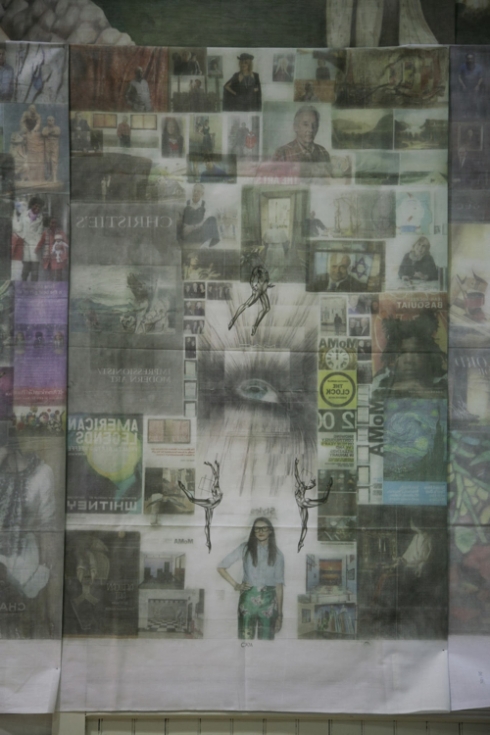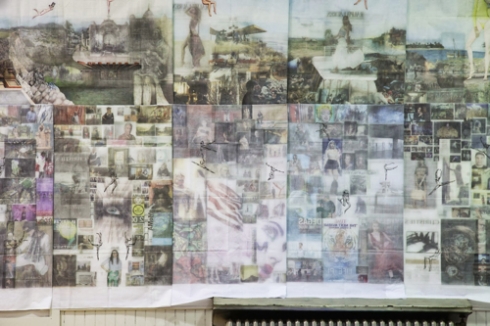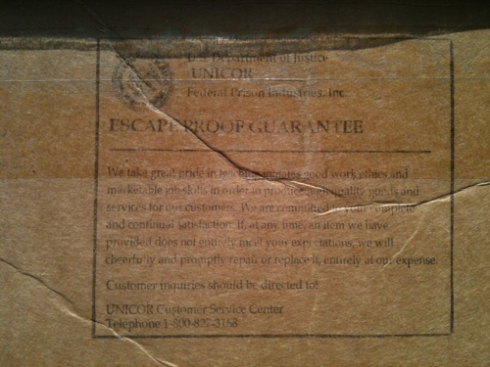
Artist Jesse Krimes stands in front of his 39-panel mural Apokaluptein:16389067 (federal prison bed sheets, transferred New York Times images, color pencil) installed, here, at the Olivet Church Artist Studios, Philadelphia. January, 2014.
The New York Times has a track record for high quality visual journalism. From experiments in multimedia, to its magazine’s double-truck features; from its backstage reportage at the swankiest fashion gigs, to their man in town Bill Cunningham. Big reputation.
NYT photographs are viewed and used in an myriad of ways. Even so, I doubt the editors ever thought their choices would be burnished from the news-pages onto prison bed-sheets with a plastic spoon. Nor that the transfer agent would be prison-issue hair gel.
In 2009, Jesse Krimes (yep, that’s his real surname) was sentenced to 70 months in a federal penitentiary for cocaine possession and intent to distribute. He was caught with 140 grams. The charges brought were those of 50-150 kilos. Somewhere in the bargaining it was knocked down to 500 grams, and Krimes plead guilty to conspiracy. The judge recommended that Jesse be sent to a minimum security prison in New Jersey, close to support network of friends and family, but the Federal Bureau of Prisons (BOP) opted to send him to a medium security facility in Butner, North Carolina — as far away as permitted under BOP regulations. That was the first punitive step of many in a system that Krimes says is meant first and foremost to dehumanise.
“Doing this was a way to fight back,” says Krimes who believes ardently that art humanises. “The system is designed to make you into a criminal and make you conform. I beat the system.”
Last month, I had the pleasure of hearing Krimes speak about his mammoth artwork Apokaluptein:16389067 during an evening hosted at the the Eastern State Penitentiary and Olivet Church Artist Studios in Philadelphia.
The mural took three years to make and it is a meditation on heaven, hell, sin, redemption, celebrity worship, deprivation and the nature of perceived reality. Krimes says his “entire experience” of prison is tied up in the artwork.

In the top-left is a transferred photo of a rehearsal of the Passion play at Angola Prison, Louisiana.


Through trial and error, Krimes discovered that he could transfer images from New York Times newspapers on to prison bedsheets. At first he used water, but the colours bled. Hair gel had the requisite viscosity. As a result, all imagery is reversed, upturned. Apokaluptein:16389067 is both destruction and creation.
“It’s a depiction of represented reality as it exists in its mediated form, within the fabric of the prison,” says Krimes. “It was my attempt to transfer [outside] reality into prison and then later became my escape when I sent a piece home with the hopes that it could be my voice on the outside in the event that anything bad ever happened and I never made it home.”
ART AS SURVIVAL
Krimes says this long term project kept him sane, focused and disciplined.
Each transfer took 30-minutes. Thousands make up the mural. Krimes only worked on one sheet at a time, each of them matching the size of the tabletop he worked on. A notch in the table marked the horizon line for the 13 panels making up the center horizontal. He shipped them home. Not until his release did he see them together.
The enterprise was not without its risks, but Krimes found favour being a man with artistic talent. He established art classes for fellow prisoners in an institution that was devoid of meaningful programs.
“Prisoners did all the work to set up the class,” says Krimes.
Once the class was in place, guards appreciated the initiative. It even changed for the better some of the relationships he had with staff.
“Some helped mail out sections,” he says of the bedsheets which were, strictly-speaking, contraband.
Krimes would cut sections from the New York Times and its supplements, sometimes paying other prisoners for the privilege.
“In prison, the only experience of the outside world is through the media.”
The horizon is made of images from the travel section. Beneath the horizon are transferred images of war, and man-made and natural disasters. Krimes noticed that often coverage of disasters and idealised travel destinations came from the same coasts and continents. Influenced by Dante’s Inferno and by Giorgio Agamben’s The Kingdom and the Glory, Krimes reinvigorates notions of the Trinity within modern politics and economics. The three tiers of the mural reflect, he says heaven, earth and hell, or intellect, mind and body.
One can identify the largest victories, struggles and crimes of the contemporary world. All in perverse reverse. All in washed out collage. There’s images of the passion play being rehearsed at Angola Prison from an NYT feature, of Tahrir Square and the Egyptian revolution, of children in the aftermath of the Sandy Hook School massacre, and of a submerged rollercoaster in the wake of Hurricane Sandy.
The women’s rights panel includes news images from reporting on the India bus rape and images of Aesha Mohammadzai who was the victim of a brutal attack by her then husband who cut off her nose. Krimes’ compression of images is vertiginous and disorienting. We’re reminded that the world as it appears through our newspapers sometimes is.



The large pictures are almost exclusively J.Crew adverts which often fill the entire rear page of the NYT. Jenna Lyons, the creative director at J.Crew is cast as a non-too-playful devil imp in the center-bottom panel.
Throughout, fairies transferred straight from ballerinas bodies as depicted in the Arts Section dance and weave. Depending on where they exist in relation to heaven and earth they are afforded heads or not — blank geometries replace faces as to comment on the treatment of women in mainstream media.

The title Apokaluptein:16389067 derives from the Greek root ‘apokalupsis.’ Apokaluptein means to uncover, or reveal. 16389067 was Krimes’ Federal Bureau of Prisons identification number.
“The origin [of the word] speaks to the material choice of the prison sheet as the skin of the prison, that is literally used to cover and hide the body of the prisoner. Apokaluptein:16389067 reverses the sheet’s use and opens up the ability to have a conversation about the sheet as a material which, here, serves to uncover and reveal the prison system,” says Krimes who also read into the word personal meaning.
“The contemporary translation speaks to a type of personal apocalypse — the process of incarceration and the dehumanizing deterioration of ones personal identity, […] The number itself, representing the replacement of ones name.”
PRISON ECONOMICS: THE HAVES & HAVE NOTS
One of the most interesting things to hear about at Krimes’ presentation was the particular details about how he went about acquiring materials. In federal prison, just as on the outside, money rules. Except inside BOP facilities the currency is stamps not dollars (something we’ve heard before). A $7 book of stamps on the outside, sets a prisoner back $9.
Access to money makes a huge difference in how one experiences imprisonment.
“People who have money have a much easier time living in prison but that is usually rare except for the white collar guys or the large organized crime figures,” says Krimes.
“Prisoners who have money in prison gain automatic respect and power because you are able to have influence over anything really — most people without money will depend on those with cash to be the buyers of whatever products or services they need.”
Without cash to hand, a rare skill comes in handy. Krimes could make art. In prison artists are afforded much respect. Ironically, free society doesn’t treat artists with the same respect, but I guess we’ve already established that we’re dealing in reversals here?!
“We had to provide some kind of skill or service in order to receive money or books of stamps. Some people cook for others, do laundry, do legal work, or artwork.”
In FCI Butner, a high-quality photorealistic portrait would go for as much as $150. Or, 20 books of stamps. Krimes did portraits and tattoo designs, spending proceeds almost exclusively on hair gel and coloured pencils.
“The majority of portraits I did were for the guys who had money or else I did them for free, for friends or those going through hard times.”
The prison sheets came for free. Krimes smiles at the irony that these sheets are made by UNICOR, the Federal Bureau of Prisons’ factory and industries arm. UNICOR makes everything from steel frame beds to bedsheets; from U.S. military boots and helmets to plastic utensils. In 2005, UNICOR generated $765 million in sales — 74% of revenues went toward the purchase of raw material and equipment; 20% toward staff salaries; and 6% went toward inmate salaries.
I’d liken Krimes’ acquisition of bed sheets to liberation more than to theft. His image transfers are appropriation more than homage. The scope of the project reflects the sheer size of American prison system. The ambition reflects that of the individual to survive, not the system to improve its wards.
That such a large statement came out of the prison sytem (in one piece!) is a feat in itself. That Apokaluptein:16389067 is so layered and so plugged into contemporary culture is an absolute marvel. That the photographs of international media are the vehicle for that statement should be no surprise at all.




More here.
All images: Sarah Kaufman


7 comments
Comments feed for this article
March 6, 2014 at 10:49 am
Christopher Paul Forbes
Awesome.
March 9, 2014 at 6:15 pm
Prison Photography | Sabine Heinlein
[…] Read more… […]
March 9, 2014 at 11:33 pm
Edwin Thomas
Note: He didn’t reverse the images. That’s just the result of an offset printing method. The printing plate that the newspaper was printed from has everything in reverse, because the image is printed by direct contact (the image on the printed paper is much like your reflection in a mirror, reversed). (In a way the newspaper images performed the same function as the plates that printed them.) So, in a way this reprinting of the images returned to their natural (reversed) orientation on the original printing plates.
March 11, 2014 at 3:01 am
Jailed Artist Creates Awe-Inspiring Mural with Prison Bedsheets and Hair Gel | Oddity Central - Collecting Oddities
[…] Prisonphotography.org, Jesse […]
March 11, 2014 at 4:12 am
Sharon Moore
You can always rely on the USA for an unfair sentence! they seem to give less for attacking people than drugs. When you consider the dirty dealings with cocaine growing countries it makes you wonder, just a little, about the hypocrisy of it all! grrrrr…mumble,moan….
April 9, 2015 at 2:35 pm
Susan M Hall | Micro Quest 3/57: Attend a Human Rights Conference
[…] finished work is titled Apokaluptein:16389067. “Apokaluptein”references the Greek origin of the word apocalypse; the numbers […]
May 2, 2015 at 8:56 am
Jesse Krimes’ Massive Mural in a Tiny Cell | Prison Photography
[…] the past, I have sung the praises of both Jesse Krimes’ huge 39 cloth-panel mural Apokaluptein:16389067 and the programming at Eastern State […]